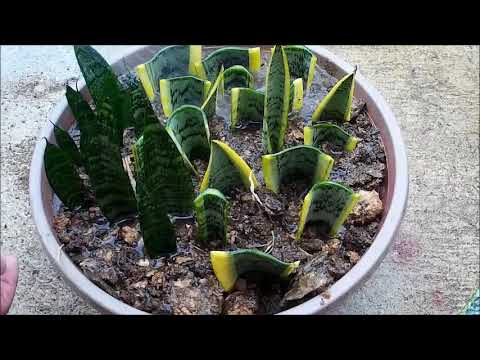Propagating your plants is a great way to learn about your plants and increase your collection while minimizing cost! You can make your own plants, or give them as gifts to your friends and family. Also, snake plant propagation with leaves is so much fun! There are so many methods for propagation of houseplants depending on what type of plant you have.
Snake Plant Propagation
Propagating your snake plant can be beneficial for several reasons.
You can reuse a damaged leaf, which may have sunburn marks or be too tall and unbending.
You might have accidentally overwatered your Sansevieria, which has caused root rot. If it is not too bad, you may still be able to save your plant by propagating the parts that are still healthy.
There may be a few leaves that you simply want to remove to help adjust the overall look of the plant.
The leaves of plants that you would otherwise throw away can be used as thoughtful gifts for friends and family.
Tips on Propagating a Snake Plant
If you want the quickest results, use healthy leaves, preferably not too old ones. If you expect an instant result, don’t expect it. Snake plant cuttings may take several months before they root. A snake plant takes at least a year to root so be prepared to practice patience. When people don’t have a good experience, they usually didn’t wait long enough.
Please make sure that you do not mistakenly turn leaf cuttings upside-down; if you do, they will not root. Cut a horizontal notch on the bottom of the cuttings. By doing this, more surface area will be available for roots to grow, and it makes it easier to track which side is up and which end we need to put into the water or soil.
The yellow margins that you see on variegated Sansevieria leaves will not appear on new leaves rooted from cuttings of that plant. You can maintain the variegation by propagating your plant by division. Gently remove leaves with roots from the main plant and repot it into a separate pot.
How to Propagate Snake Plants Cuttings in Water
Cut a leaf with sharp, clean scissors and carefully cut it near the soil. Propagating a single leaf in a tall glass vase gives a dramatic effect. You can cut it in multiple sections to propagate many new plants from just one leaf.
Leaf top cuttings, with the pointy tip, tend to have higher success rates and tend to sprout roots and new leaves sooner. Use the cuttings out shortly after cutting them to dry them out and condition the cut edges so that they become calloused. This will help keep your plants young and avoid rotting.
Leave the leaf cuttings in a glass container with just enough water to cover the bottom portion of the cuttings and place them in a place with brilliant indirect light. Change the water every couple of days.
Next, the waiting period begins. Don’t worry if you still haven’t seen any roots after one month. It is perfectly normal. You might have to wait another month for roots to grow, and even longer for leaf pups to emerge.
Before you pot the succulents up into succulent soil with good drainage, wait until the roots are at least an inch deep. Add some perlite pumice to improve drainage even more.
How to Propagate Snake Plant Cuttings in Soil
This method skips the water part in favor of just cutting your leaf, letting it callus over, and sticking it in soil. Keep the soil extremely lightly moist for the early stages of rooting, and less as the plant becomes established. Unless the leaf tip is intact, the leaf-cutting won’t grow anymore. Once a new leaf is growing, you can cut the original cutting down.
Use rooting hormone powder on your cuttings to speed up the process. Dip your cuttings first in water, and then dip the bottom quarter inch in rooting powder. Place your cutting in a small pot with slightly moist succulent soil, and plant it a half inch deep.
Critical Reminders to be Noted!
Be sure you read this section carefully.
Whenever you are going to propagate a leaf, cut it off with a sharp pair of scissors. Then cut it into several segments. You should cut each segment to at least 2 or 3 inches long.
When cutting the segments of the leaves, you need to know which part of the leaf is closest to the soil. You can not flip the leaf segment upside down and then bury it in the ground. It will not root.
Putting the segments into the soil should not be a problem if you cut a notch on the corner of the leaves to indicate which end to insert.
Hence, the end of the leaf segment that was originally closest to the pot will be the end that is inserted into the soil for propagation.
Problems in Propagation
Even though snake plant propagation is pretty foolproof, it is still possible that some cuttings just don’t take as well as others. If your snake plant cutting is not growing roots, you may have to give it more time. As long as it is not rotting and the water is fresh, roots could still appear.
Leaves get mushy and brown
Look out for snake plant cuttings that start off mushy and then turn brown or black. This means they are rotting and should not be used.
If this occurs in cuttings sitting in water, it indicates that the cut had not fully dried before it was put in water. When cuttings directly in soil start rotting, it usually means they have been overwatered.
You might be watering the cuttings too often or putting them in a pot that is too large or doesn’t have drainage holes on the bottom.


